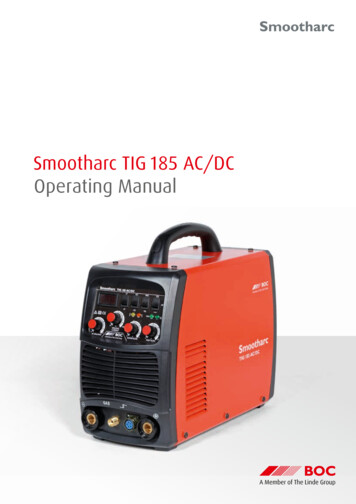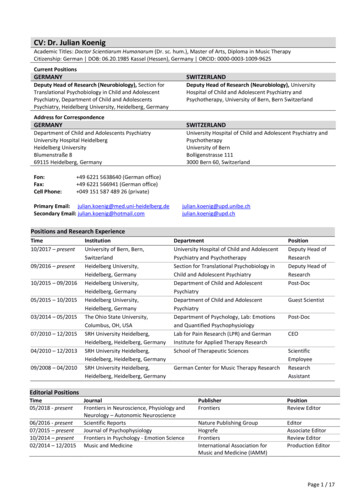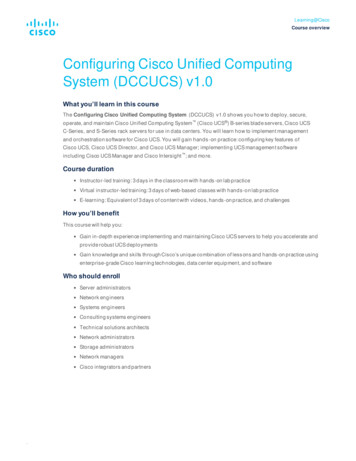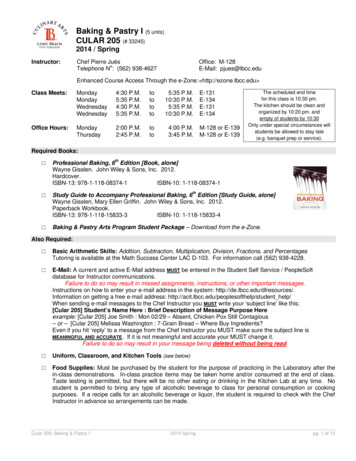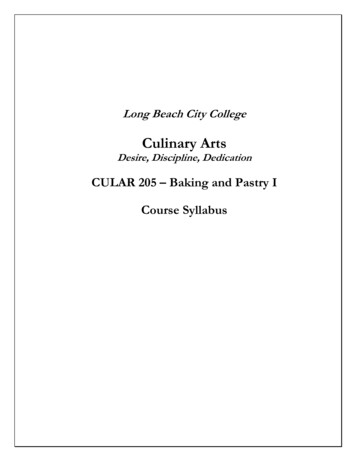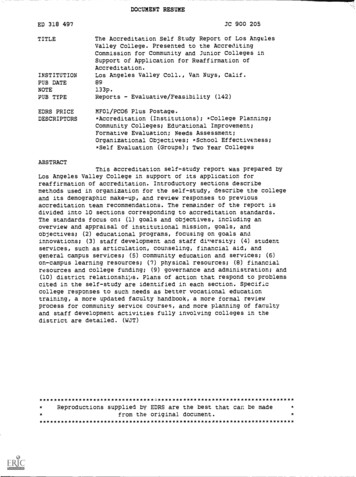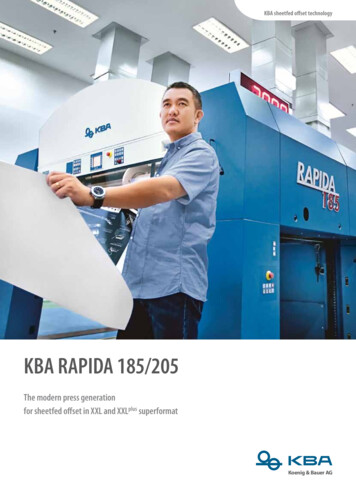
Transcription
KBA sheetfed offset technologyKBA RAPIDA 185/205The modern press generationfor sheetfed offset in XXL and XXLplus superformatKoenig & Bauer AG
Concept2 KBA Rapida 185/205
No half-measuresAll-new designThe benchmark in superlarge format knows two names: Rapida 185 and Rapida 205.Since the arrival of these presses, the whole world of sheetfed offset printing in XXLformats has been redefined.KBA superlarge-format presses are todayavailable in countless configurations,from straightforward four and five-colourversions to special-purpose presses with12 units and sophisticated inline coatingsystems, in all cases featuring a level ofautomation on absolutely level par withthat of the Rapida series for medium andlarge formats. In fact, a number of theoptions for the smaller presses are evenstandard on the Rapida 185 and Rapida205. The superlarge-format press is thusin no way merely a “blown-up” Rapida162. The laws of physics alone alreadynecessitated a totally new press design.With its maximum production format of1.51 x 2.05 metres, the Rapida 205 istoday the largest sheetfed offset presson the market in terms of sheet size. Butnot only that. The press boasts a printarea of more than three square metres,and nevertheless performs at speeds ofup to 9,000 sheets per hour. That addsup to an output of almost 28,000 squaremetres of print per hour for users of theRapida 205.Presses in this format class wereoriginally expected to excel as efficientmeans of production for poster printers.And they are still today dependableworkhorses in this market segment.Alongside, however, a broad spectrumof further applications has evolved:Rapida 185 and 205 presses are alreadyin successful operation in the mostdiverse fields from calendar and bookproduction, via POP displays to largeformat and high-volume packaging.Take a look for yourself and experiencethe fascination of incomparable performance on the Rapida superlarge-formatpresses – and your new opportunities inXXL sheetfed offset.KBA Rapida 185/205 3
Format-focused featuresFor all eventualitiesA sheet pile for the giant formats of the Rapida 185 and 205 presses can easily weighup to three tonnes, and this load has to be carried and transported safely and reliablyby the pile board in the feeder.FeederUnique in the modern sheetfed offsetarena, and an enormous advantageespecially for superlarge-format users,is the shaftless feeder of the Rapidapresses (DriveTronic Feeder). Dedicatedelectronic drives take care of the exacttiming of all feeder motions, namely:· drive for the feeder head· feed table belt drive with sheetdeceleration at the front lays· drive for the main pile with jerk-freecontinuous pile lift· drive for the auxiliary pile (fornon-stop operation) with jerk-freecontinuous pile liftThe electronically controlled AC drivesfunction without the previouslyindispensable mechanical link to thedrive of the press itself. They ensurea constant pile height relative to thefeeder head with no differences due tostepping intervals. The pile lift, at thesame time, is much smoother – also atthe point of pile reunion in non-stopoperation. Numerous components proneto wear, such as timing gears, cardanshafts, belt drives, etc., are renderedsuperfluous.Sheet sensorsThe Rapida 185 and 205 presses can beequipped with two different double-sheetsensors. The standard ultrasonic doublesheet detector is an ideal choice forpractically the whole range of substratesfrom paper to board, and even metallisedstocks. For thicker substrates such asmulti-ply or corrugated board, it can becomplemented by an optional capacitivesensor.Feed table with two wide suction belts. The mechanicaldrive shaft between the feeder and the first printing unithas been eliminated.Sheet infeedFacilities for central setting of thefront lay cover height, motorised skewcorrection of the infeed line and parallelvariation of the gripper margin from theconsole enhance the ease of operation atthe infeed. Motorised positioning of thefront and side lays is a standard feature.Guide rollers can be added to optimisethe handling of rigid materials such asheavy board or even corrugated stock. Atimed-action guide shaft, furthermore,assists precise transfer of the sheets intothe press.4 KBA Rapida 185/205
FeederDriveTronic Feeder with automatic non-stop facilities: No need to forego fully automatic pile changing even in XXLplus formatFor dusty stocks, an optional dustextraction system can be added to thepress configuration to minimise theoccurrence of hickeys and to save theresultant additional washing times.Gentle accelerationThe infeed maintains the widely provenprinciple of a swing arm operating frombelow, combined with timed pneumaticand mechanical sheet guiding elementsfor reliable and scratch-free feeding ofthe sheets to the feed drum.KBA Rapida 185/205 5
Mechanics
Robust and vibration-freeAll cast in the same mouldThe printing units of the Rapida 185 and 205 comprise a monolithic substructurebox with mounted inking unit towers. This superior design principle is the key to theoutstanding rigidity of the printing units.Substructure boxUnlike alternative substructure designswhere individual elements are boltedtogether, this design solution is immuneto deformations, even under extremeloads.After assembly, the direct, tight jointsbetween the Rapida substructures meanthat the whole press is effectively asingle torsionally rigid block, carryingthe printing towers. This modular designpermits identical substructures to be usednot only for all printing units, but also forcoater and dryer towers.GrippersAll Rapida gripper systems operate witha universal gripper bar spacing. Thissuperior design solution means that thereare no adjustments whatsoever to bemade to the grippers to accommodatechanges in substrate thickness.Further support for sheet transport isprovided by the roughened, ceramiccoated gripper tips and the serratedgripper pads with flexible plastic inlays.The gripper tips are characterised by theirhigh friction values and wear resistance.The technology used not only permitsreduction of the gripper pressure, but alsoachieves a constant self-cleaning effectto significantly enhance the service life ofthe grippers.Together, these components stand forutmost precision at sheet transfer.Box cast in a single pieceDriveThe Rapida 185 and 205 presses aredriven by a single motor, irrespective ofthe number of printing units. The drivepower is always introduced to the firstimpression cylinder gear, from where itis distributed exclusively via a singlecontinuous gear train.Fast-rotating drive components areoften a source of vibration. The practiceproven Rapida drive technology, basedon precisely manufactured helical gears,is able to eliminate the typical originsof vibration, such as longitudinal driveshafts, transmission gear boxes and bevelgears.BearingsIn view of the higher bearing forces whichnecessarily arise with bearer-to-beareroperation, the use of plain slide bearingsinvolves a much greater risk of bearingdamage compared to antifriction rollerbearings. It must elsewhere be counteredby incorporating a defined play intothe system, though this in turn bringsnegative effects for the print result.Play-free multiple-row antifriction roller bearings for theplate and blanket cylindersKBA Rapida 185/205 7
Sheet transferCleverly designed air systems provide for high substrateflexibilitySheet travelSlim and flexibleBoth the Rapida 185 and Rapida 205 remain true to the sheet travel principles oftheir smaller sister presses. Double-size impression cylinders and transfer systems arealso standard features of this press class from KBA. The proven “7 o'clock” cylinderarrangement has similarly been preserved.Impression cylinders and transfer systemsThe double-size impression cylinders andtransfer systems guarantee low-curvaturesheet travel placing a minimum of stresson the sheet. This cylinder geometryhas proven particularly advantageousfor a wide substrate flexibility. Aday's printing schedule can vary fromlightweight papers right up to N, G, For even E-flute board. To help minimisemakeready times, all important settingscan be made remotely from the central8 KBA Rapida 185/205ErgoTronic control console, where thegraphic screen input boxes have beenarranged for maximum ergonomicconvenience.Reliable sheet transfer .Sheet travel is based on an aerodynamicparadox, whereby fans and guide platesbeneath the gripper transfer points areable to create a so-called vacuum aircushion. This provides for smear-free andconstantly stable sheet transfer through
the whole press. The settings for the airsystems are transmitted synchronouslyto all the printing units from the controlconsole, for which purpose optimisedsettings can be saved, and recalled atany time later for fast press presettingin the case of repeat orders or new jobsusing the same substrate.Drum shells and cover plates limit theflexibility of a press and also restrictaccess to the individual printing unitsubstructures. For this reason, the Rapidapresses are designed for smooth sheettravel without drum shells or coverplates. Removable sheet guide platesfacilitate maintenance and service work. for paper and boardFor materials up to 200 g/m2, so-calledcomb suckers smooth the sheets asthey enter the new impression gap andin doing so prevent slapping againstthe blanket cylinder. Further systemcomponents are available to handleheavy and corrugated boards. Allelectronically controlled components canbe adjusted from the ErgoTronic controlconsole, where their settings are alsosaved for repeat jobs. For the handling ofextremely rigid substrates, a blower barsystem assists the passage of the sheetsat the impression gaps. The mechanicalsheet guiding equipment for heavy stockscomprises special guide bars above theimpression cylinders.Double-size impression cylinders and transfer systems provide for low-curvature sheet travelAir settings can be regulated finely from the control consoleKBA Rapida 185/205 9
Ink and waterFast reactions and process stabilityThe superlarge-format Rapidas are equipped with inking and dampening units to satisfyeven the most exacting quality demands. An exceptionally short inking unit with just16 rollers provides for fast reactions, low start-up wastage, production stability andshort washing times.The ink keys of the ColorTronic ink ductseach cover a 30 mm zone. The tips ofthese ink keys are carbide blades. Incombination with the ceramic-coatedduct roller, they ensure that the wholemetering system is able to operate freeof wear. The function principle of theink keys guarantees exact, bleed-freeseparation of the individual zones andrenders equalisation software superfluous.The fact that the duct roller is drivensynchronously with the press providesfor a fast ink transfer from the meteringpoint to the vibrator roller. Requestedink metering corrections are realisedquickly and without fluctuation. Thespecial locking mechanism at the ink ductensures a constant clearance between themetering elements and the duct roller andcontributes similarly to a high degree ofreproducibility.Process stability and qualityThe open inking unit geometry providesfor optimum heat dissipation. A furtherpositive effect is fast attainmentof a correct ink-water balance. Theoutstanding process stability this bringsensures that the printed products satisfythe highest quality demands. An absoluteminimum of maintenance and adjustment,as well as fast removal and replacement ofthe rollers, are similarly clear illustrationsof the user-friendly design.10 KBA Rapida 185/205Schematic representation of the inking unitHeat exchanger of a glycol cooler
Inking and dampening unitsDampening unitThe Varidamp film-type dampening unitis a four-roller unit with an additionaloscillating bridge roller which can be setto various operating positions. The speedof the dampening unit is automaticallymatched to the press speed to ensurea uniform application of dampeningsolution. A switchable differential drive,which can also be activated duringproduction, serves to remove hickeys. Formore stubborn cases, additional manualhickey-pickers can be applied to selectedzones of the plate.Inking unit temperature controlThe superlarge-format Rapida presses arealready prepared for the installation ofinking unit temperature control in theirstandard versions. This means that theduct roller and the three distributor rollersalready possess the necessary bores forcoolant circulation, which minimises thefinancial outlay for retrofitting of the fullsystem.One concept for controlled dissipationof the heat arising from the press andits peripherals is a closed-circuit glycolcooling installation. The use of watercooled peripherals in conjunction with acentral recooling system is able to reduceheat emissions in the printshop by up to50%.The system components which can beintegrated into an external cooling circuitare: Inking unit temperature control anddampening solution conditioning Air cabinets Dryer cabinets Dryer modulesKBA Rapida 185/205 11
WashingMulti-purpose washing systemWashing in half the timeThe Rapida superlarge-format press generation is the product of consistent furtherdevelopment on the basis of experience gained in daily printing practice with theRapidas 130-162a.One important element is the multipurpose washing system for impressioncylinders, blankets and plates. Theactual washing principle implementedon the Rapida 130-162a presses has beenmaintained, though numerous detailmodifications have permitted furtheroptimisation.12 KBA Rapida 185/205The washing beam of the new systemtravels along a linear path, with arack-and-pinion combination providingfor pivoting of the beam at the threedifferent positions for plate, blanketand impression cylinder washing. Theadvantages are to be seen in the greaterpositioning accuracy and reduced wear tothe system components.Even greater efficiencyIn conjunction with the Impact washingsystem, blanket and roller washingcan now be performed simultaneously(CleanTronic synchro). Cloth replacementis very simple and can be handled bya single operator. A further benefit ofthis system is the precisely controlledfabric advance by way of an electricmotor, which provides for more effectiveutilisation of the cloth. The length ofcloth is measured during the windingonto the permanent spindle in thewashing beam. The printer is informed
as to the remaining cloth length and thecorresponding number of washing cyclesvia the console monitor and can preparethe imminent replacement in good time.CleanTronic UVThe waiting times prescribed byindustrial safety legislation for thedrying systems on UV presses naturallyhave a negative effect on productionefficiency. Two minutes standstill mustbe taken into account for the lamps tocool before washing, and a further twominutes standstill for evaporation of thesolvent after washing. With CleanTronicUV, the certified UV interdeck dryersfrom KBA can remain in standby modeduring blanket washing. This represents adecisive plus for productivity for UV andhybrid applications.Time savings with CleanTronic UV(basis: 2 washing cycles per hour)Without CleanTronic UV5,000 sheets in 30 minutesWith CleanTronic UV5,000 sheets in 30 minutes5,000 sheets in 30 minutes2 minutes lamp cooling2 minutes lamp cooling3 minutes washing3 minutes washing2 min. wait – risk of flash fire2 min. wait – risk of flash fire2 minutes lamp warm-up2 minutes lamp warm-up5,000 sheets in 30 minutes3 minutes washing5,000 sheets in 30 minutes3 minutes washingKBA Rapida 185/205 13
FAPC:Automatic Plate ChangerSimple and preciseFor a modern sheetfed offset press in this format class, the attainable printing speed isby no means the sole parameter determining business success. Another essential factoris the time spent on plate changing during makeready. FAPC – Fully Automatic PlateChanger – sets the standards for the superlarge-format sector.FAPC – Fully Automatic Plate ChangerAll Rapida 185 and 205 pressesincorporate the fully automatic platechanging system FAPC as a standardfeature, and are thus able to achieveplate changing times which have in thepast only been known from smaller formatclasses. When they reach this size, theplates naturally call for a different formof handling. For this reason, the operatoris offered an optional lifting facility forloading and unloading of the plate holderson the tower guards.be placed in the holders in advance. Theactual change process is then activatedfrom the control console, with the firststep of the process being automaticzeroing of the register settings in theselected printing units. To enable manualregister corrections – which are by nomeans unusual on sheets of this size –the rear clamping bars are split into foursections. FAPC changes the plates in twocycles, taking no more than approx. 3minutes to do so – irrespective of thenumber of printing units involved.The Rapida presses are equipped withsingle holders rather than plate cassettes,so as not to place unnecessary limitationson flexibility. The new plates can alreadySplit rear clamping bars facilitate any manual registercorrectionsFAPC in action14 KBA Rapida 185/205
RegisterErgoTronic ACR:Spot-on accuracyIt could hardly be simpler: Working with ErgoTronic ACRAutomatic Camera Register Control (ErgoTronic ACR) provides the operator with anextremely efficient system for fast colour registration even for this giant format.ErgoTronic ACR comprises a cameraand the corresponding software. Itdetermines any register differences, andcalculated correction values are thentransmitted automatically to the lateral,circumferential and diagonal registersystems on the individual printing units.To be able to make proper use of theautomatic function, it is necessary tooverlay special measuring patches whenexposing the plates. In view of therequired precision, these patches can onlybe incorporated effectively using a CtF orCtP system.With its 50x magnification, the cameracan also be used to inspect freely selectedareas of the image.KBA Rapida 185/205 15
Refined finishesReproducible coating qualityKBA has already focused on the anilox coating technology for several years. Thesuperlarge-format coater tower, too, is designed for ultimate coating quality and simpleoperation.The chosen positioning of the aniloxroller brings the advantage that it is nolonger necessary to adjust the roller tocompensate substrate thickness changes.Simple access to the coating forme cylinderis also guaranteed.Fast coating plate changesThe register-punched coating plate isinserted into the front clamps, whichare then closed pneumatically. Withsubsequent automatic mounting,pneumatic clamping at the rear and finaltensioning, the total changing time iscomparable to that for plate changing inthe printing units.The anilox roller is 355 mm in diameter.This gives it an exceptional flexural rigidityand provides for a more even coatingapplication across the whole sheet width.Each coater tower is fitted with a hoist tofacilitate exchanging of the anilox rollers.The rollers can be placed on a special reston the top of the coater tower, or elselowered into a transport box on the floorby slewing the hoist beam.The LithoCoat system brings a number ofdecisive design solutions and significantbenefits with regard to ease of operationand quality. With this system, the bladechamber is applied to the anilox roller andautomatically compensated by way of ahydro-pneumatic blade pressure controlfeature. The extremely low contact pressureensures a considerably longer service life ofboth the blade and the anilox roller.Constant coating applicationThe positioning of the blade chamberagainst the anilox roller is a linear action,as a result of which the angle of the bladerelative to the roller and consequently alsothe volume of coating applied is alwaysconstant. With six actuating cylindersdistributed evenly across the whole widthof the chamber,
The printing units of the Rapida 185 and 205 comprise a monolithic substructure box with mounted inking unit towers. This superior design principle is the key to the outstanding rigidity of the printing units. Substructure box Unlike alternative substructure designs where individual ele
